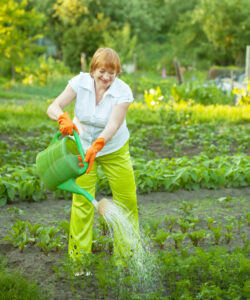Tips For Watering And Sprinklers: The Lawn Correctly
 When watering the lawn, it is common for many people to give it all the importance it deserves. They think using fertilizers or compost is enough to have an impeccable garden. The truth is that the most important thing is not only to do it but to do it the right way.
When watering the lawn, it is common for many people to give it all the importance it deserves. They think using fertilizers or compost is enough to have an impeccable garden. The truth is that the most important thing is not only to do it but to do it the right way.
The two most common mistakes are that it becomes damaged or dies from dehydration. Even excess water ends up rotting it. The trick is always to keep it hydrated, but only enough to water it frequently, not overdo it.
How Do You Know When To Water Your Lawn Or Not?
An important factor when watering your lawn is the weather. Naturally, the climate will be drier, more varied, or more humid depending on where you live, so the amount of watering will depend on this. However, there are two important details to consider, these are:
If There Are Signs Of Dehydration
Regularly, in areas with drier climates, the first mistake made is not watering enough. There comes a point when the grass begins to appear yellowish, the leaves curl, and the footprints take longer to erase from the grass.
If There Is Excess Water
Watering the grass abundantly will also highlight imperfections. Excess water will cause the roots to rise to the surface in search of oxygen, causing them to turn yellow or rot. Fungi can also grow around the leaves, which is the most noticeable.
Knowing this, it is very important to recognize your soil type since it will determine the irrigation frequency, like the climate. Some soils absorb water better than others; however, if we take clay soil, for example, it prevents absorption.
It would help if you also considered the shape of the garden before watering the lawn. This is important since, in an inclined garden, the water will run, and the soil will not be able to absorb the residual water.
Now, as for exactly when to water, that depends on where you live. If, for example, you live in rainy or humid areas, the best option would be to do it between 10 pm and 6 am. Normally, gardens benefit from this humidity or rain, and the watering frequency can be reduced.
 In hotter or arid places, the best option will be to water the grass early in the morning, preferably before dawn. This will help reduce water use since, thanks to evaporation, it will be lost during the day. If there is no rain, you must water at least twice a week.
In hotter or arid places, the best option will be to water the grass early in the morning, preferably before dawn. This will help reduce water use since, thanks to evaporation, it will be lost during the day. If there is no rain, you must water at least twice a week.
On the other hand, if it is located in an area where the temperature is normally low, it will be watered before 10 am or after 6 pm. This way, the amount of evaporated water will be minimized, and the soil can absorb it without problems or damage to the grass.
What Damage Does Watering The Lawn Cause Incorrectly?
Overwatering deprives the grass of air, damages it, and harms the garden soil. The soil can become compacted or hardened, making it difficult for proper root growth. Likewise, if the soil is not regularly nourished with fertilizers, the water will cause the few nutrients to drain away and not reach the roots.
There are only two ways to water your lawn: manually or with an automated system. It is watered manually with a hose, so you must ensure it is watered evenly and precisely in the designated area. For the other, the ideal and simple thing would be a sprinkler system since sprinklers are placed easily and variedly.
As there are different types of grass, you should know which of these systems to water your lawn properly.…
